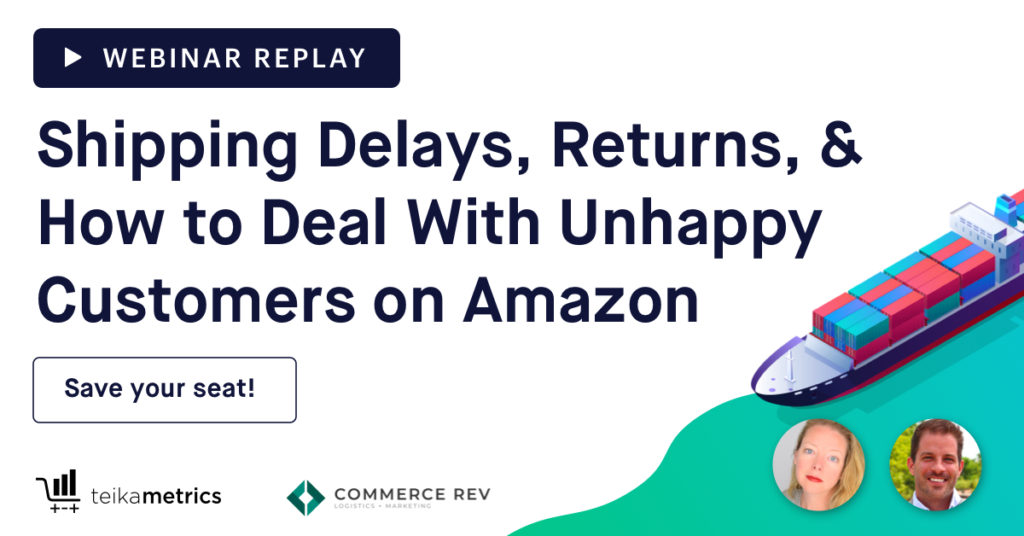What are brands experiencing, right now, in terms of shipping delays, customer returns, and customer feedback? We asked Eric Wohlstadter, President at CommerceRev, to give us some boots-on-the-ground information about these things and more based on what they’re seeing from the many brands they manage.
Here’s What We Covered:
- How to decrease the amount of customer returns you get on Amazon
- Customer returns and how they impact your brand
- Shipping delays to customers and what that means to your Account Health
- Tips and tricks for dealing with unhappy customers
Show Notes:
- Check out CommerceRev
- Connect with Eric Wohlstadter on Linkedin
- Contact Eric at ewohlstadter@commercerev.com
- Connect with Liz Downing on Linkedin
- Check out Teikametrics
- Follow Teikametrics on Instagram and Linkedin
- Register for AdMax to maximize your growth in 2022
Watch the Full Replay:
Key Teika-ways
2:23 – Shipping delays in the marketplace
This is the crazy time of year regardless, but then you have the COVID factor this year so, yes definitely what we are seeing is Amazon with their lead times, and things like that are definitely delayed. In addition to that, you’ve got the quantity limits on the FBA side now with COVID, so seeing a lot more merchants doing kind of a little bit more of an FBM to FBA split. So that is kind of what we are seeing in the marketplace just because it is getting harder to do FBA.
3:18 – Pivoting from FBA to FBM
I think that we saw that starting up last year. And again, just taking a step back going back, I don’t know, 10 years ago when I first started with FBA, I mean, there were no restrictions. You could pretty much send in anything that you wanted. Clearly, Amazon has made many moves over the years to basically say, “We’re not a storage center. We’re a fulfillment logistics company in that regard.” So, they’ve kind of over the years continually put in different metrics and safeguards and make sure that they were stocking the top-selling items effectively. So, yes, over that time, and especially in the last couple of years with COVID, definitely saw that impact a lot of sellers and I think FBM is definitely a viable strategy, especially these days. So, overall, it’s going well.
6:40 – Consequences for late shipment
Obviously, the worst one is just getting your account suspended. You can submit a plan of action and things like that for late shipments. But that’s I think just the worst case that can obviously happen. It’s going to impact your metrics more than likely on the buybacks. It might not be that important to you if you’re the only one selling the product. But if you’re a reseller, that’s obviously going to have an impact on your ability to get the buybacks if you’re not adhering to Amazon’s kind of stringent customer experience standards. So, that’s definitely a component. That’s one thing that could happen as well. But the worst case is if you could get suspended.
12:46 – Best Practices for on-time orders
There are numerous best practices Amazon gives to you. There are quite a few. The first year is pretty obvious, so you obviously want to list only the items that you can ship by or before the expected ship date. The best practice, obviously, is the shipping confirmation by the expected ship date. Confirm the orders as soon as the package is handed off to the carrier. One thing we didn’t talk about before, just kind of want to make everyone aware doesn’t necessarily, it does impact shipping metrics, not necessarily your late shipping metrics, but carrier first scans are kind of a big deal too. So, kind of get into that and the next best practice. So, it’s important we know when the carrier scans in, and obviously, that is going to depend, if you’re using FedEx, UPS, USPS. If you’re kind of doing all of them, you’re going to have different things, different times when they’re going to come to your warehouse.
So, you just want to make sure that we strive to ship the same day as the order is received. Obviously, there are some caveats to that. Number one being is we want to make sure that we have a same-day shipping cutoff within our warehouse and everybody that is out there adheres to that standard. So, we have a shipping cutoff of 2:00 PM Central from our warehouse that matches with our order cutoff time within Amazon. That order cutoff cannot be earlier than 2:00 PM local time, except for the weekends. And again, kind of going back to that question previously, that’s kind of where this stuff gets a little bit in the weeds and complicated, but just generally speaking, just want to make sure you have a same-day shipping cutoff that’s achievable. And make sure that matches within your Seller Central account in the shipping settings. One thing that we’ve actually had to do in regard to all this and carriers coming in picking up at different times, I know there’s been at least a few different times where we’ve had to talk to and we’ve had I think we’ve been pretty good with the carriers like UPS and FedEx and DHL or you’re just talking to our rep if we had an issue with carriers coming in at a little bit later. But I think the real shortage we’ve had is with the post office. So, I know there are certain instances where we’ve actually contacted kind of the postmaster to see if we could figure out how we could work with them just to make sure that we’re meeting these metrics and they’re scanning things in time. So, that would be one thing I would recommend, if you have a rep on behalf of the carrier you can talk to you and just kind of make sure everyone’s communicating what your expectations are. And the same thing with your warehouse.
16:48 Forecast for the state of international shipping for 2022
I know that what I’m seeing, especially for US-based people that are sending things to FBA, in particular, in other countries, it’s not looking good. And people who are receiving into the United States. I mean, as we all know, the supply chain is just a big old mess right now internationally.
Assuming things are status quo or hopefully get better, that’s probably still going to be a year or so before everything is fully recovered, although there does seem to be some progress, at least getting things in from overseas on the ports. And I know that’s maybe not what we’re talking about. But there does seem to be a little bit of progress right now from what I’ve seen them on just the manufacturing side getting products from overseas.
19:15 – Adjust handling times
More of a proactive approach, the next best practice would be if you can adjust your handling times to provide the buyers with realistic delivery time. So, for example, if I know my warehouse is behind by a day just because of the crazy order value right now, I’m going to increase my default handling time by at least one day. So, that way again, accommodating for them being behind and not impacting my late shipment metric.
19:43 – Review Order Handling Capacity
There actually is a new functionality. It’s called review order handling capacity. And it’s effectively a way to kind of throttle your orders. So, you would set the maximum number of seller fulfilled orders. You can reliably ship every day. And Amazon more or less will kind of throttle your orders based on that.





